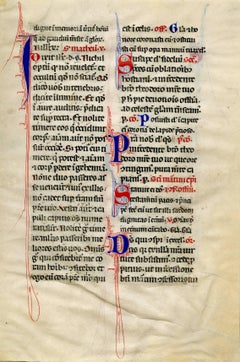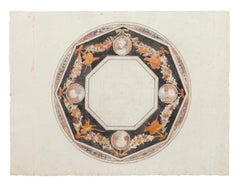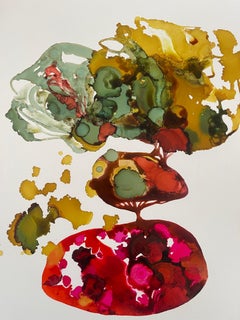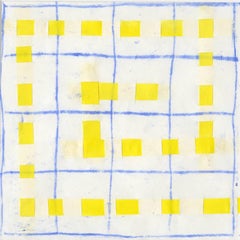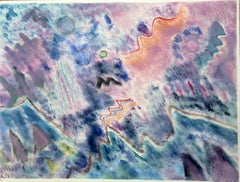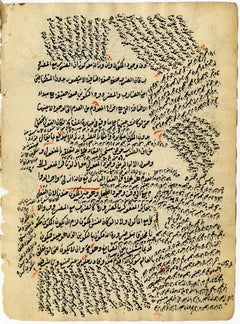18th Century and Earlier Abstract Drawings and Watercolors
to
2
Overall Width
to
Overall Height
to
2
19
2,298
5,202
1
7
29
62
85
138
349
326
312
275
1
1
1
2
2
1
1
1
1
1
1
Period: 18th Century and Earlier
Folio from Communion of Saints, Reading from the Book of St. Matthew.
Located in Fairlawn, OH
Readings from the "Communion of Saints": folio from an Italian Missal
Pigment on vellum
Mid 17th century
Provenance:
Otto F. Ege (1888-1951)
Phillip Duechnes Bookseller, New York, c. 1948
References And Exhibitions:
Otto F. Ege Box Folio 27
Ege describes these folios as: Epistolary (Epistolarium), Italy, Middle 15th century
Latin Text: Rotunda or Round Gothic Script, square rhetorical neumes
Sister folio are in the following rare book libraries:
Case Western Reserve University
Cincinnati Public Library
Cleveland Institute of Art
Cleveland Public Library
Denison University
Kent State University
Kenyon College...
Category
Old Masters 18th Century and Earlier Abstract Drawings and Watercolors
Materials
Ink, Vellum
Illustration - Ink and Watercolor on Paper - 18th Century
Located in Roma, IT
Illustration is a drawing in watercolor on paper realized by an anonymous artist of the 18 century.
With a drawing on the rear.
The State of preservation is good, except for diffu...
Category
Contemporary 18th Century and Earlier Abstract Drawings and Watercolors
Materials
Watercolor, Ink
Related Items
Underworld
Located in San Francisco, CA
Paula Valenzuela
Underworld, 2025
Alcohol ink and watercolor ink on Yupo paper
14 x 11 inches
This one-of-a-kind work on paper comes unframed. External, visible frame and glass in s...
Category
Contemporary 18th Century and Earlier Abstract Drawings and Watercolors
Materials
Paper, Ink, Watercolor
16B: Modern, Abstract Blue, White, & Yellow Grid Pattern Painting in White Frame
Located in Hudson, NY
oil on vellum
8 x 8 inches, 13.25 x 13.25 in white frame
This work on paper is offered by Carrie Haddad Gallery, located in Hudson, NY.
This modern, abstract blue and white painting...
Category
Contemporary 18th Century and Earlier Abstract Drawings and Watercolors
Materials
Oil, Vellum
Donise English16B: Modern, Abstract Blue, White, & Yellow Grid Pattern Painting in White Frame, 2015
$600 Sale Price
20% Off
H 13.25 in W 13.25 in D 1.5 in
Untitled Mid-Century Modern Geometric Abstraction
Located in New York, NY
Burton Wasserman
Untitled Mid-Century Modern Geometric Abstraction, 1967
Color pencil on thin vellum paper
Hand signed and dated by the artist on the front
Frame Included: elegantly ...
Category
Abstract Geometric 18th Century and Earlier Abstract Drawings and Watercolors
Materials
Color Pencil, Vellum
$1,500
H 13.25 in W 13.25 in D 1.25 in
Liz Sweibel, Untitled #1 (MOL Comfort, 6.27.13, 11.46 am) 2015, Post-Minimalist
By Liz Sweibel
Located in Darien, CT
These thread-and-vellum drawings document the aftermath of the earthquake and tsunami in Japan in March 2011. They began as a reaction to photographs of the devastated landscape, p...
Category
Post-Minimalist 18th Century and Earlier Abstract Drawings and Watercolors
Materials
Thread, Vellum
$900
H 15 in W 18 in D 1 in
Jump - Abstract Ink Ecoline Painting, New Expression
Located in Salzburg, AT
Grażyna Rigall is a painter, illustrator, author of stage designs and music videos. - The artist is interested in the merging of the world of fauna and flora with the world of man, p...
Category
Contemporary 18th Century and Earlier Abstract Drawings and Watercolors
Materials
Paper, Ink, Watercolor
Liz Sweibel, All Fall Down 2, 2019, Thread, vellum, Abstract Drawing
By Liz Sweibel
Located in Darien, CT
The drawings in this series are from photos of marine accidents, and made of thread, knots, and vellum. All were completed in 2019.
At sea, stacks of containers topple from a load...
Category
Post-Minimalist 18th Century and Earlier Abstract Drawings and Watercolors
Materials
Thread, Vellum
Liz Sweibel, All Fall Down 1, 2019, Thread, vellum, Abstract Drawing
By Liz Sweibel
Located in Darien, CT
The drawings in this series are from photos of marine accidents, and made of thread, knots, and vellum. All were completed in 2019.
At sea, stacks of containers topple from a load...
Category
Post-Minimalist 18th Century and Earlier Abstract Drawings and Watercolors
Materials
Thread, Vellum
Liz Sweibel, All Fall Down 4, 2019, Thread, vellum, Abstract Drawing
By Liz Sweibel
Located in Darien, CT
The drawings in this series are from photos of marine accidents, and made of thread, knots, and vellum. All were completed in 2019.
At sea, stacks of containers topple from a load...
Category
Post-Minimalist 18th Century and Earlier Abstract Drawings and Watercolors
Materials
Thread, Vellum
Untitled (101.13)
By Tilman
Located in London, GB
Crayon on vellum. Unframed.
In a broader sense, Tilman’s works on paper function as an archive of the artist’s ideas and observations. The visual information derives from various so...
Category
Minimalist 18th Century and Earlier Abstract Drawings and Watercolors
Materials
Crayon, Vellum
Untitled (257.11)
By Tilman
Located in London, GB
Crayon on vellum. Unframed.
In a broader sense, Tilman’s works on paper function as an archive of the artist’s ideas and observations. The visual information derives from various so...
Category
Minimalist 18th Century and Earlier Abstract Drawings and Watercolors
Materials
Crayon, Vellum
Untitled (266.11) (Abstract painting)
By Tilman
Located in London, GB
Crayon on vellum - Unframed
In a broader sense, Tilman’s works on paper function as an archive of the artist’s ideas and observations. The visual information derives from various so...
Category
Minimalist 18th Century and Earlier Abstract Drawings and Watercolors
Materials
Crayon, Vellum
Untitled (137.13)
By Tilman
Located in London, GB
Crayon on vellum - Unframed
In a broader sense, Tilman’s works on paper function as an archive of the artist’s ideas and observations. The visual information derives from various s...
Category
Minimalist 18th Century and Earlier Abstract Drawings and Watercolors
Materials
Crayon, Vellum
Previously Available Items
1993 "Dust and Devils" Oil Pastel Abstract Modernist Female Artist
Located in Arp, TX
Elaine Kaufman Feiner (1922-2018)
"Dust and Devils"
1993
Oil pastel on paper
40"x30" unframed
Signed and dated in pencil lower right, signed, titled and dated on reverse
Very Good C...
Category
Abstract 18th Century and Earlier Abstract Drawings and Watercolors
Materials
Paper, Oil Pastel
17th Century Anonymous Persian Philospohical text
Located in Fairlawn, OH
Unsigned as usual
Nastaʻliq script
Paper; cream-colored Middle Eastern paper
Black ink with red high lighting or rubrication
Category
18th Century and Earlier Abstract Drawings and Watercolors
Materials
India Ink
Double-Sided Leaf from the Shah Namah (Epic of Kings)
Located in Fairlawn, OH
In "naskhi" script, an Arabic form of cursive writing based on certain laws governing the proportions between letters.
Ink, color and gold leaf on paper
Sheet: 13 3/8 x 9 1/8"
Category
18th Century and Earlier Abstract Drawings and Watercolors
Materials
Gold Leaf
Recently Viewed
View AllMore Ways To Browse
Mister Cartoon
E Brodsky
Sophia Loren Vintage Poster
Adam De Ville
Air Canada Poster
Alfred Walter Williams
Arnolds Pankoks
Bern Posters
Bronze Sculpture Swimmer
South Pacific Art
Stanislavs Kreics
Submarine Painting
Texas Western Painting
Tudor Oil Painting
Vintage Air Canada Posters
Vintage Western Painting
Virgil Williams
W Richards Paintings
